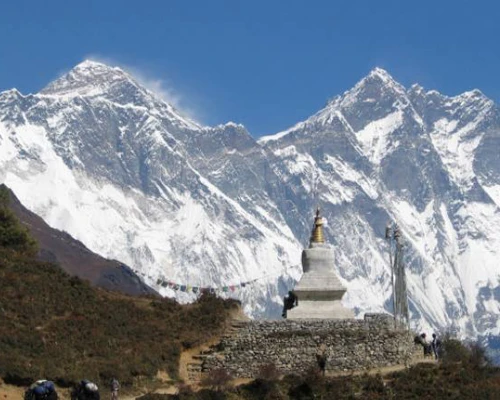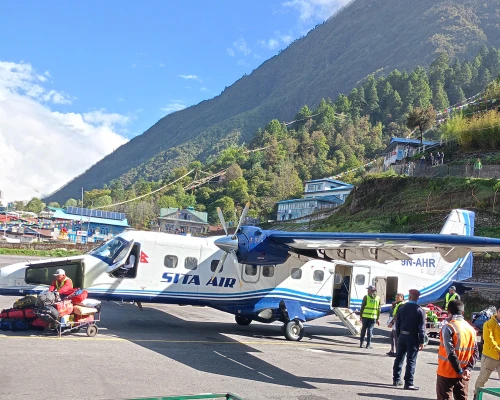Best Season For Everest View Trek
Trekking in the best season of the year offers spectacular views and scenery of Mt.Everest and other higher mountains. Nepal has 4 seasons: Summer, Autumn, Winter, and Spring. The following list includes detailed information on Everest View Trek Best Season;
Trekking in Spring Season
It is the peak and highly recommended season of the year. It falls in March-May. During these months, the Everest trekking routes fill with adventurers lovers. This period of a month is the best time to observe the magnificent clear picture of the great Himalayas and its beautiful surrounding areas.
During these periods of time, the colorful and vibrant rhododendrons light up the entire region of Everest, and crossing these beautiful forest fills the heart with mixed emotions of joy, excitement, peace, refreshed, and many more.
Days are quite warmer as the temperature can reach from 17°C to 25°C and Nights are cold as temperature reach to -2°C.
Trekking in Autumn Season
Besides Spring Season, Autumn is the second best season for Everest View Trek. This season falls from September to November.
The weather during autumn is moderate i.e. neither too hot nor too cold, which is very suitable while trekking for long days. There may be a slight possibility of light rain but the views afterward are marvelous. Days are warmer (15°C to 20°C) whereas Nights are bearable cold -5°C. The views and scenery during autumn are crystal clear, providing a wide picture of snowy mountain peaks, green forest and farmlands, clear blue sky, and cool refreshing breeze.
Trekking in Winter Season
It is one of the least favorite seasons of the year for Everest Panorama Trek (Everest View Trek). As the weather is freezing cold during night time. the month of winter but it’s an opportunity for adventure and challenge lovers to experience the extreme conditions of this region. If you prepare the perfect Bagpack there will be easy to complete your trip.
Frequent snowfalls and strong winds are the main obstacles while trekking and views and scenery are not that clear and appealing. Thick snow covers the entire trekking route which make it quite a difficult to walk on. During winter, the temperature goes up to -10°C during nights.
Trekking in Summer/Monsoon Season
This is the hottest and wettest season of the year in Nepal. Hence, considered as “ low-season” for trekking. The weather is too hot during daytime with frequent heavy rainstorms, strong winds, hailstorm while the night is bearable cold if it doesn’t rain.
Trekking during this season can be risky and boring as the rain clouds fully block the views and scenery of mountain peaks and surroundings. Changes in flight schedules or even cancellations due to rain for the safety of trekkers.
Trails to Everest Viewpoint are very slippery and swampy due to heavy rain which may result in some accidents.
Therefore, think before you travel. Choose the best season for the year for Everest View Trek to enjoy this magical journey fullest.
How Difficult is Everest View Trek?
As for the Everest View Trek Difficulty, the trek is moderate and difficult at some places. Trek to Namche Bazaar is a challenge in itself. As the first half to Sagarmatha National Park (a UNESCO World Heritage site) is easy and moderate but the final half to Namche Bazaar is tough. The trails are very steep and sloppy and take 6 hours of hiking to reach the capital of the Khumbu region, Namche Bazaar. Trek from Namche to Tengboche is moderate to difficult as the trails are low slope paths to the steep path. Our guide/Potter helps to complete your hiking.
Besides trek distance and duration, the season also plays a vital role which directly affects the difficulty level of this trek. Summer and Winter seasons are more difficult to trek as compared to Spring and Autumn seasons. In case of bad weather or unfavorable condition. Nepal Everest base camp leader makes a decision during the trek.
The trek difficulty is measured based on the following aspects;
Trek Distance and Duration
Sometimes Trekking for long distances and duration is the main challenge and difficult part of Everest region trekking. Trekkers have to walk steep pathways also crossing suspension bridges, forests, etc for hours to reach night stay destination which is a very challenging task. But, with proper rest and energy supply (water and food) these difficulties can be solved easily.
Accommodation
During the peak season/time for Everest trekking, trekkers have a hard time finding good hotels. By chance, if you didn’t get any hotels then it arises a very bad/difficult situation. You have to stay outside in extreme cold which directly hampers your health and trip. Nepal Everest Base Camp has a connection to well-known hotels in this area. So, you don’t have to worry about your accommodation even during the peak season of the year.
Climate and Weather
The weather in the mountains is unpredictable can’t forecast what the weather would be. if there will be unpredictable weather causing troubles while trekking. So in this difficult situation, team leader or guide will decide what further actions to take.







 based on 19 reviews
based on 19 reviews
